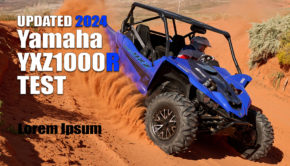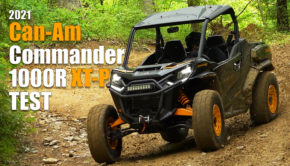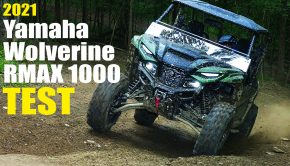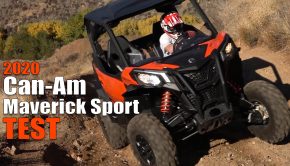Published on August 4th, 2024 | by Joe
2024 Can-Am Maverick R Test Review
2024 Can-Am Maverick R Ratings
Summary: Its acceleration and speed are nearly unrivaled. Handling is stable, precise, and race worthy at all speeds. Suspension performance is well matched to the engine for rough, whooped-out, high-speed driving. Interior comfort sets the standard in the sport SXS segment. Overall, the Can-Am Maverick R lives up to the hype.
4.3
3 Month est
With their historic racing heritage that began with dirt bikes, Can-Am is dead serious about being the performance leader in the sport SXS segment, as we can attest to from our recent test of the highly impressive 72” wide Maverick X3 X RS Turbo RR. Looking to further separate themselves from the competition in the turbocharged one-liter segment in racing and solidify themselves as the overall performance leader in the world of sport SXSs, Can-Am developed their latest supercar, the 240HP Maverick R, all new from the ground up, boasting industry leading horsepower, dimensions, and suspension travel from a major manufacturer.
With both analog and fly-by-wire suspension options available, depending on the trim level, we snagged the Maverick R X RS, with computer controlled Smart-Shox technology, to see what kind of performance the top of the line Can-Am Maverick R has to offer.
Trim Packages
The 240 HP Maverick R is available in four two-seat trim packages for 2024 starting with the base model for $35,499. For an added $2,900, the Maverick R X gains a 10.25” touch screen display/infotainment system, rear facing camera, telescopic steering wheel with infotainment controls, LED accent lights up front, and four-point harnesses for $38,399. We’re not sure why four-point harnesses aren’t standard on all trim packages at this performance level.
$4,200 more gets you the Maverick R X RS. It gains the X package features, 16” beadlock wheels, upgrade from 30” to 32” tires, plus the addition of a front facing camera. The biggest upgrade in performance on the X RS is a switch from Fox Podium 2.5 QS3 shocks with three position compression adjustment to Podium RC2 shocks, with larger diameter 3.0 shocks out back. More of a race shock, they feature Fox’ internal bypass design for a plusher ride on high-speed hits. High and low-speed compression and rebound damping adjustments allow for a much higher level of fine tuning. The X RS retails for $42,599.
Finally, an added $1,700 gains you our test unit, the X RS package with Smart Shox. It gains all of the X RS upgrades plus Smart Shox featuring on the fly, computer controlled compression and rebound damping adjustments with three ride modes to choose from. The premium package comes at a premium price of $44,299.
For our pick as to which one we’d buy and why, make sure to watch till the end.
Styling, Interior, and other Details
The Maverick R came to market with a new look that’s distinctly Can-Am with its low cage profile and sleek body design. LED lighting with LED headlights and Can-Am signature accent lights are found out front with tail and brake lights out back.
Gone are the quarter doors from the X3, replaced by proper half doors helping keep you a little cleaner and drier. Can-Am uses a pull strap on the inner front of the doors for opening, a race car feature that seems a little unrefined on a vehicle that will primarily be used for hard core recreation. The doors open widely rearward making getting in and out easy, like the X3, when closing the doors took a little lifting or slamming to latch.
Well bolstered, high back bucket seats with pass throughs for the retractable four-point harnesses are sat low in the cockpit. Automotive style sliders allow the seats to be moved forward and rearward plus they can be raised or lowered with the use of tools. They are arguably the best, most comfortable seats in any OEM sport SXS. The steering wheel is both tilt and telescoping adjustable, allowing you to put the wheel perfectly within reach for most drivers. At 6’4”, test driver, Allen Knowles, found the cockpit to be spacious and quite comfortable.
With so many features to control, the cockpit is a little cluttered with buttons and switches. The layout could have been a bit more intuitive, but you get used to it.. The 10.25” touchscreen is beautiful with controls and readouts for the machine and viewing of the front and rear facing cameras. However, it requires the use of a call phone for GPS and some other functions so the experience isn’t yet quite as seamless as Polaris’ Ride Command. Redundant controls mounted on the steering wheel are a great touch.
Sight lines out of the front of the car are good, but backing up without the benefit of the rear facing camera or good rear view mirror is a little difficult. Overall, the cockpit is Can-Am’s most refined, yet, putting a priority on comfort and speed, which is what you want with this much performance on tap.
For on-board storage, cup holders are found between the occupants and in the passenger side floorboard. 2.1 gal of in-cab storage is pretty limited, consisting of a passenger side glove box along with an enclosed cell phone holder center dash. In front of it is a small box center dash, which required the lid to be taped down to keep in place. The bed can haul up to 200 lbs. It can haul a spare tire, but it’s not very deep and space is limited somewhat by the turbo cover.
Engine Performance
Powering the Maverick R is a brand new 240 HP turbocharged, 999T, inline triple cylinder, Rotax engine, displacing 999cc with four-valves and DOHC per cylinder. It features an integrated intercooler with a high performance air filter to keep the 54mm turbo running cool. The turbo is directly mounted to the engine block providing integrated tubeless oil and water cooling while reducing vibration. Two radiators are used to keep the engine running cool.
The new crankcase, cylinder, and head are held in place by 8 tension rods to provide a stiffer, more robust, engine package. The cylinder features a closed deck design for greater rigidity for greater head gasket durability while improving cooling. Plasma coating inside the cylinder reduces friction with the forged alloy pistons and improves heat dissipation. The hydraulic housing with a dry sump design helps provide consistent lubrication at extreme vehicle angles. Air and fuel are fed to the engine via fuel injection with dual injectors per cylinder for more consistent fuel delivery throughout the RPM range pumped from its 13.2 gas tank.
The top end mates up to a dual-range, 7-speed transmission for less maintenance and power loss than a belt driven CVT. A dual clutch design allows for quicker shifting and acceleration. The transmission features an auto shift mode that shifts at different RPMs based on the intelligent throttle control’s drive mode. You can override auto mode’s gear choice with the paddle shifters for a short time, which is especially beneficial when downshifting for turns, or you can put the transmission in manual and bang gears with the paddle shifters.
The electronically controlled gas pedal integrates with Can-Am’s intelligent throttle control with four drive modes: normal, sport, sport +, and custom, which affects throttle response, engine performance, and shift timing in the transmission’s auto setting. Normal is tuned for smoother throttle response and filtering unwanted pedal inputs, upshifting at lower RPMs for a smoother, quieter ride. Sport mode provides fast throttle response with shifting at higher RPMs for quicker acceleration. Sport + provides some magic. It further enhances throttle response and shifting speed. At idle, Sport + runs on only two cylinders using the vacuum from the third cylinder to pre-spool the turbo to prevent turbo lag for even faster acceleration when you’re on and off the gas. Finally, there’s the Custom setting, which lets you preset and access your favorite power steering, engine, transmission, suspension, and differential settings with one single selection.
The engine fires up with a push of the start button with the DESS key installed. Selecting between the transmission’s high and low range is done by the push of a button that provides no direct feedback as to which mode you’re in without referencing the display. You can shift between ranges without stopping at low speeds.
Power is mind blowing and responsive, as you’d imagine, throughout the RPM range. It’s especially impressive from the mid up, aided by lightning fast shifting from the 7-speed DCT. The various drive modes perform just as advertised. Normal mode makes the R a little mellower, more manageable, and quieter running. Acceleration is notably faster accelerating from a stop or low speeds with the turbo pre-spooled in Sport +, but driving in more wide open terrain, it didn’t seem necessary and notably impacted fuel economy in auto shift modes. So, we spent most of our time in Sport mode.
Auto shifting works well in most situations, so that’s where we left it a majority of the time. Shifting was lightning fast, smooth, and quiet in auto or manual. Overall, the engine and transmission performed fiercely and pretty flawlessly.
The drivetrain features four modes including two-wheel drive. Four-wheel drive with Can-Am’s Visco-Lok auto locking front differential has two modes, Trail and Trail Active modes. Trail Active makes the front differential lock in more quickly, which is beneficial in slippery or crawling situations. Smart-Lok allows you to fully lock the front differential for full-time locked in four-wheel drive.
Trying out the various drive modes, we found Trail Mode to work well nearly everywhere in the dry, West Coast terrain using Smart-Lok added traction for extremely technical conditions, accompanied by slightly stiffer steering. Visco-Lok works well enough that we found diff-lock unnecessary where we tested. Still, we applaud the drivetrain for its versatility and effectiveness.
Overall, the engine and drivetrain are thrilling and effective in the environment for which they were developed to excel.
Chassis and Suspension
The Maverick R is built on a brand new frame and suspension system with improved geometry for better handling and durability with 33% greater torsional rigidity than the X3. The frame is constructed of dual phase steel with a v-shaped lower frame for improved obstacle clearance. Rubber double bound bushings are used throughout the chassis for reduced squeaking and maintenance. Bolt and frame loads are reduced up to a factor of two reducing stress on components.
Sway bars are used at both ends with dual A-arms up front and a 4-link trailing arm setup out back. Taller forged aluminum knuckles are used at both ends. This is said to reduce load on the upper front A-arms and ball joints by a whopping 85% and 15% on the tie rods. Out back it’s claimed to reduce load on the upper links by 38% and 45% on the toe link.
The new front-end geometry features a revised kingpin angle and reduced scrub radius for improved steering accuracy and reduced bump kickback. Mounting the upper front ball joints over the tires puts them more in line with the car’s center of gravity, which is said to reduce the vehicle’s tendency to roll in corners by 50%. That, and placing the shock mounts on the lower A-Arms to transfer the load to the bottom of tires, helps keep them rolling flatter in turns for improved grip and handling.
25” of front and 26” of rear suspension travel are controlled by Fox, gen 3, Live Valve Podium 2.5 shocks front and 3.0 shocks rear. They’re equipped with Fox’ Internal Bypass valves to reduce high-speed harshness and feature Can-Am’s Smart Shox technology. New electronically controlled main piston and base valves monitor oil flow for more precise control. The system monitors wheel speed and direction, tuning compression and rebound independently for better bump absorption, flatter cornering the less dive under braking and acceleration. They’re able to change the damping from one extreme to another within .017 sec. Smart Shox puts three base tunes at your fingertips that can be changed on the fly between comfort, sport, and sport plus. Maverick R is equipped with Can-Am Gen 2 Dynamic Power steering letting you select between three levels of assistance.
Maverick R rolls on a square tire and wheel setup with the X RS models outfitted with 32×10-16 ITP Tenacity XNR tires mounted on 16” flow formed, beadlock wheels at both ends. The wheels feature 6 lugs to maximize strength.
All Maverick R’s feature a claimed 17” of ground clearance. Overall, the car measures in at 78.1” wide with a massive 108” wheelbase, 140” overall length, standing 71.5” high. Dry weight is 2,250 lbs.
Suspension performance is good all-around with a few small details to snivel about. Chatter bumps are on the harsh side. Adding throttle or braking transfers weight with Smart Shox adding compression damping to prevent dive. This makes suspension action less fluid adding to the harshness. Allen ran the shocks in their softest setting a majority of the time to minimize this.
Over mid-size hits and high-speed whoops, suspension action is excellent. It keeps the car riding high in the travel, eating up the hits and keeping the car tracking straight. Moments of air time were also dealt with beautifully by the shocks. Our only complaint on bigger hits were in harsh G-outs where the rear end had a tendency to blow through the travel and kick a bit. You can reduce this tendency some by switching to the suspension’s Sport or Sport + setting, but that will further magnify the harsh feeling through stutter bumps.
Overall, the shocks seem a bit under-sprung and over-dampened. We feel that computer controlled suspension, including the Maverick R, would benefit from greater adjustability providing the ability to tune how much the shocks ramp up the damping to fight pitch, roll, and deal with bumps. Skilled drivers would benefit, although it would complicate things for the higher income, less skilled drivers that computer controlled shocks are designed to cater to. In slow-speed, technical situations, Allen felt the R would benefit from a little more suspension articulation. With the car’s massive footprint, the suspension should be able to be tuned for better independent movement without any real adverse effects on stability.
Steering precision is good, especially in one of the auto-locking four-wheel drive settings. A little more weight transfer from non-computerized shocks should make it even better with properly adjusted suspension. Even in four-wheel drive, the massive power output and stable platform make drifting corners a breeze. Cornering, sidehill and high speed stability are all rock solid. Power steering, with its various modes, kept steering light and eliminating unwanted bump feedback.
Brakes
Stopping power is provided by steel braided, brake line equipped, four-wheel, hydraulic disc brakes with three piston calipers up front mated to 265mm rotors. Dual piston calipers are used out back mated with 255mm rotors. The brake pedal has also been made both larger and stiffer on the Maverick R.
The brakes offer sufficient power, but feel a little soft. They require more pedal movement and pressure than we’d like to get the job done. We suspect that the piston is a little larger than necessary, taking longer to build up pressure. A smaller piston should deliver the braking power we’d expect from the brake’s specs.
Conclusion
The Maverick R might be the best performing sport SXS on the market, but we don’t believe that Smart Shox offers the best suspension performance available in the Maverick R lineup.
We could buy the base model X package with its touch screen and back up camera integration and have $5,900 left over for our favorite tires and beadlock wheels. We may actually prefer the X package’s QS3 shocks over their Smart Shox.
If we wanted the best performance available from the Maverick R off the showroom floor, we’d pass on the Smart Shox like most racers do, and, instead, we’d go with the X RS package with fully, manually adjustable Fox RC2 shocks, spend a few days testing suspension settings for the ultimate ride, and let her rip!
Our only complaints with our car are its busy cockpit, harsh ride through stutter bumps,and the brakes could engage with a little better feel and less pedal pressure.
Its acceleration and speed are nearly unrivaled. Handling is stable, precise, and race worthy at all speeds. Suspension performance is well matched to the engine for rough, whooped-out, high-speed driving. Interior comfort sets the standard in the sport SXS segment. Overall, the Can-Am Maverick R lives up to the hype.









